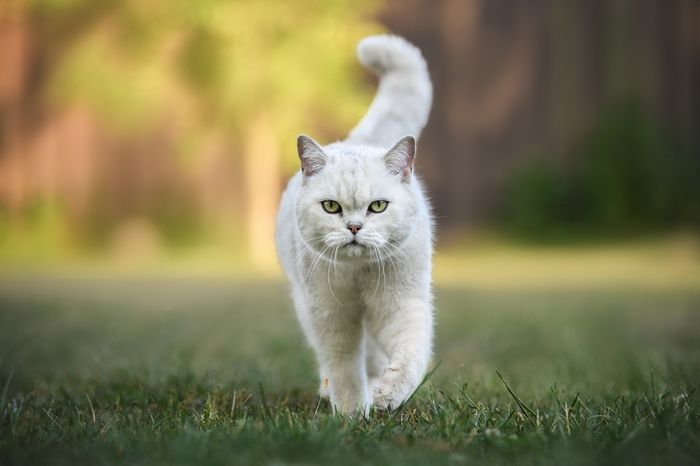Tail Talk: Understanding the Meaning Behind Cat Tail Movements
Updated July 27, 2023.

Healthy cats can control their tails from the base all the way to the tip—a considerable journey. The ability to move their tails is an essential part of their balance and nonverbal communication. Just like the human brain, they determine what the command should be. The nerves deliver this command to the muscles, and the tail is manipulated accordingly. It's no different from how we control parts of our bodies.
A cat's tail accounts for 10% of its bones. And about 90% of tail positions boil down to modulating distance—whether to come closer, maintain the current space, or move further away. But there are many other things these movements can indicate, like anxiety, anger, or contentment.
We spoke to expert cat behaviorist and founder and president of All Cats All The Time, Rachel Geller, Ed. D., to gather insight into cats' tail movements and what these communicate to us.
» Do you have an indoor cat? Discover how to create an enriched home for your cat
6 Cat Tail Movements and What They Mean
Let's look at what a cat's tail tells you.
1. Tail Up
You may be wondering, "Why do cats walk with their tails up?" If a cat's tail is straight up and it approaches another cat or a human, this usually means it has a friendly and trusting relationship with that individual.
This behavior further signifies the following:
- Trust
- Desire to engage
- Confidence
- Contentment in its environment
- Approachability
Cats developed these mannerisms while living in the wild. A tail, visible above tall grass or shrubs, was a practical and necessary means of communicating readiness for interaction with other cats. As cats evolved, they continued to use the same tail language with humans, regardless of their familiarity.
"This is significant because cats are master communicators," says Geller. It's not uncommon for people to claim their cat bit or scratched them out of the blue. In reality, the cat likely signaled its discomfort or desire for distance multiple times with tail movements. Ignoring these signals can lead to a cat feeling it has no choice but to bite or scratch.
» Does your cat enjoy physical affection? Check out why cats lift their bums when being petted
2. Tail Wagging
What Does It Mean When a Cat Wags Its Tail?
"I often advise people to consider the cat's body language. A straight back is neutral. Anything below the horizontal line is negative, and anything above it is positive. It's a simplified view, but it can be a helpful guideline," says Geller.
Here are some specific explanations of tail-wagging meanings:
- Lower: Uncertainty, cautiousness, potential agitation
- Flicking back and forth: Irritation, agitation, reservation, uncertainty about a situation, pain
- Low flicking: Warning sign to humans to keep their distance; irritation or discomfort
- High flicking: Excitement, contemplation, playfulness. For example, an indoor cat watching a bird from a window could indicate enjoyment or curiosity by flicking its tail high.
- Swaying side to side: Focus, mild annoyance
3. Question Mark-Curved Cat Tail
A cat's curled tail indicates happiness and could even suggest a playful mood. Cats use this gesture toward humans when they want to play or are feeling happy. But, just like humans, cats all have different styles of communication, so this is not an exclusive sign of positive emotions.
This is also a common greeting among companion cats or cats living together, generally signaling contentment and well-being. They approach each other without agitation, indicating an amicable relationship.
4. Tail Whipping
While a dog's tail wags faster when it's happy, a cat's doesn't. So, why do cats slap their tails? Usually, it signifies:
- Aggression
- Alertness
- Nervousness
- Irritation
- Wanting to increase or maintain distance
Expert Tip: Immediately stop if you see this movement. Ignoring it can result in the cat escalating its behavior. It might progress to a hiss, which signifies fear, or a growl, indicating aggression. If you continue to disregard the cat's signals, it might resort to swatting, scratching, or biting.
» Learn ways to tell if your cat is stressed or anxious
5. Tail Twitching
Some tail movements can signify vastly different moods. So, what does it mean when a cat's tail twitches? Twitching is often a sign of anxiety in a cat, but it can also indicate excitement. Cats' tails sometimes twitch when they're about to mark their territory—if they're going to spray, you might notice a twitch first. Typically, this signifies that the cat is feeling stressed, anxious, or insecure.
However, some cats' tails twitch while they're sleeping or napping, and this is usually no cause for concern. In this context, it's just an involuntary movement, akin to experiencing a cramp or twitching during sleep in humans.
6. Puffed Tails
"My short-haired cat could puff up his tail quite impressively when he wanted to," explains Geller. "Ultimately, cats are not naturally aggressive and would prefer to avoid fights. They prefer to intimidate and use posture to defuse the situation."
Of course, some cats, especially short-haired ones, won't be able to fluff their tails as much as long-haired breeds like the Maine Coon. But they have other forms of nonverbal communication, like:
- Puffing up their tails as much as possible while doing lashing movements
- A posture that simulates a pounce, like wiggling their butts
- Rolling their ears back and down, signaling readiness for a confrontation by protecting their ears
- Faking an attack
Fun Fact: A cat gets a puffy tail when happy, too, especially when playing. Often playtime mimics their natural hunting behavior, like pouncing or preparing for an attack, which shows why their tails may get puffy in these instances.
What to Do if Your Cat's Tail Is Injured or Broken
"Remember, the tail is an extension of the spinal cord, so an injury there can be compared to a human having an injury on their back or neck, which would also cause significant discomfort," explains Geller.
Some signs and symptoms that something may be wrong with your cat's tail are:
- Tail hanging limp at base
- Dragging along the floor
- Bent cat tail
- Difficulty urinating
- Leaking or dribbling urine
- Diarrhea or signs of incontinence
- Incoordination or difficulty walking with the rear legs
If your cat is experiencing these symptoms, limit its movement. Since cats use their tails for balance, an injured or broken tail can be debilitating and affect their gait. Ensure your cat has close access to its litter box, food, or water.
» Find out if pet insurance for your cat is worth it
Let the Tail Guide You
Cats communicate with their tails expertly. They can express many things to other cats and humans this way. While tail movements focus on helping your cat judge distance, navigate its surroundings, and keep its balance, there are many insights into mood and well-being too.
It's important to keep your eye on any changes in your cat's tail movements, as it could indicate a larger issue. In the unfortunate case of an injury or break, be sure to follow our guidelines and head to a vet as soon as you can. This way, your feline friend can get the best care to alleviate discomfort and improve its quality of life.


